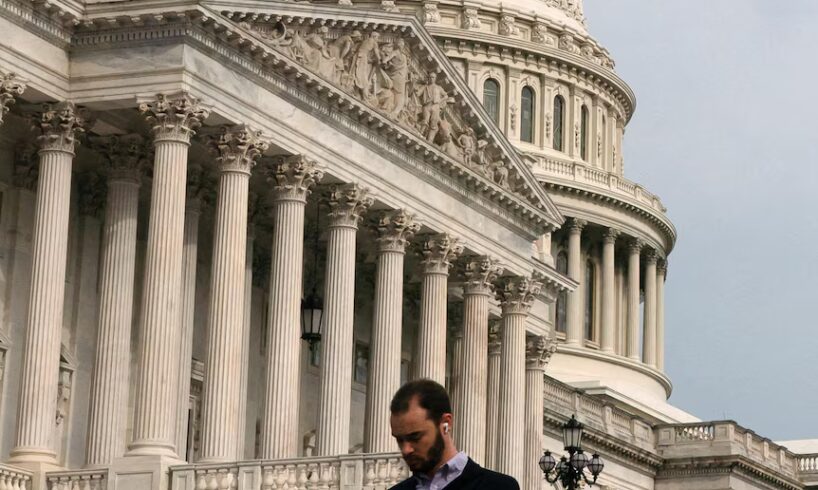
The US government has shut down for the first time in almost seven years as politicians hold firm in a stand-off over federal funding.
The shutdown began just after midnight on Wednesday, local time, following Democrats and Republicans in the Senate voting down each other’s stopgap measures to keep funding flowing.
While shutdowns have been a possibility since 1976, when Congress introduced the modern budget process, they’ve been a relatively rare occurrence.
Here’s a look at how previous shutdowns have played out.
What is a government shutdown?
It’s when government agencies across the nation are temporarily shuttered and staff are furloughed due to a lapse in federal funding.
The US government shutdown has begun. Here’s what that means
Congress must pass an appropriations bill for funding to be allocated, but this process is being held up in the Senate.
Democrats want an extension for tax credits that make healthcare more affordable added to the budget, but Republicans aren’t willing to make the compromise.
While Republicans currently hold the majority in the House of Representatives and the Senate, they can’t pass the bill on their own.
That’s because they need 60 votes in the Senate to advance the bill to a vote. They’re currently seven seats short.
How long did previous shutdowns last?
Most shutdowns are relatively short affairs.
Half have lasted just three days or less, and mostly extended over a weekend, when the impact of reduced government operations is minimal.
But there’s no guarantee the current shutdown will be over that fast.
The longest shutdown in history, which was also the most recent, occurred under Donald Trump for 35 days from 2018 to 2019.
That was almost two weeks longer than any that had come before.
How are shutdowns resolved?
The short answer is through negotiation.
That can be through the party in power agreeing to the opposition’s demand, the opposition conceding, or by both parties agreeing to temporarily extend government funding while they continue talks.
For Mr Trump’s marathon 35-day shutdown from 2018 to 2019, it was the latter.
The stalemate broke out because the president was seeking to have a $US5.7 billion carve-out for constructing the US-Mexico border wall included in the appropriations bill.
A bitter blame game is pushing the US towards the precipice
Democrats argued it would be a waste of public funds and instead proposed measures that would bolster existing border security measures.
Eventually, Congress agreed to reopen the government as both parties continued their negotiations — a plan Mr Trump endorsed, despite not securing money for the wall.
A source told CNN at the time that a “contributing catalyst” to ending the shutdown was the rise in air traffic controllers calling in sick, which was causing safety risks and flight delays and cancellations.
The shutdown of 2013, which occurred during Barack Obama’s second term, was sparked by disagreements over health.
Republicans were pushing for measures that would delay funding for the Affordable Care Act, which sought to make health insurance more affordable for Americans.
Mr Obama and Democrats refused to agree, as they would have given Republicans more time to make changes to the act.
The government shut down for 16 days as a result of the impasse, until Democrats agreed to apply stricter income verification rules.
How do shutdowns effect the economy?
Shutdowns usually don’t leave huge marks on the US economy.
Even the longest shutdown was a blip on the radar, with the Congressional Budget Office estimating it shaved just 0.02 per cent of the 2019 US gross domestic product.
But the impact will be felt by the federal workforce.
US government shutdown impacts felt across America
While many are required to continue working, they won’t be paid for their time until after the shutdown ends.
Those who have been furloughed will miss out on pay cheques altogether.
The last shutdown was the equivalent of three lost pay cheques, leaving many unable to make mortgage payments, repay bills, or afford food.
Ryan Sweet, chief US economist at Oxford Economics, estimates the shutdown and temporary loss of income for federal workers could shave 0.1 to 0.2 per cent from the nation’s annual growth rate in the fourth quarter for each week the government is closed.
Some of that will be recovered once it reopens.
“The economic costs of government shutdowns are normally minimal unless they last for several weeks,” Sweet wrote.
But the damage could be worse this time because Mr Trump has threatened the mass firing of federal workers.
That would risk even more upheaval for a workforce that’s already been purged by the president.
ABC/AP





